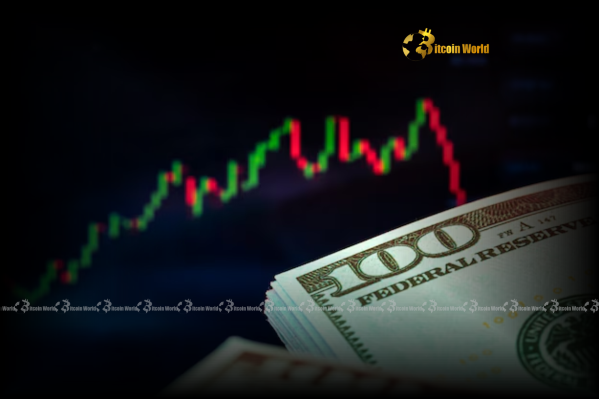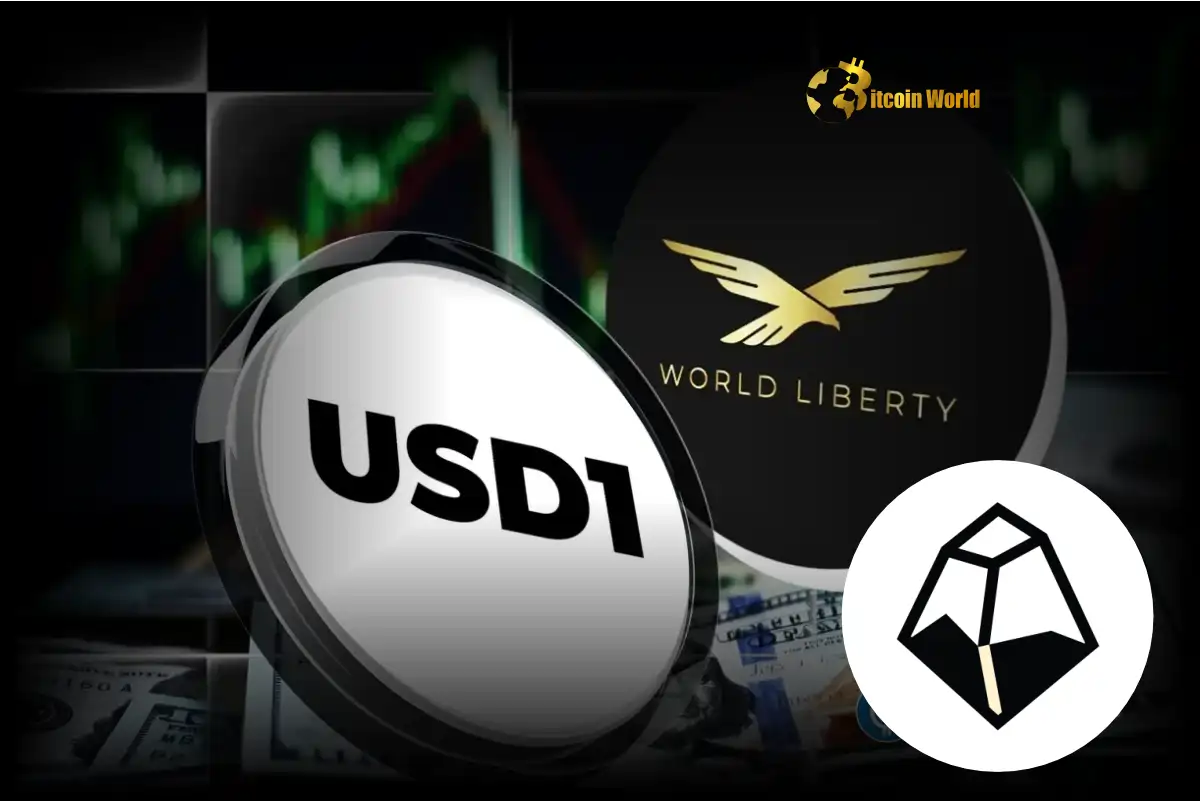BitcoinWorld

US Dollar Decline: Unveiling Optimism in Global Markets
The cryptocurrency market, often seen as a barometer for global investor sentiment, is intricately linked to traditional financial shifts. When major currencies like the US Dollar decline, it sends ripples across all asset classes, including digital assets. Recent developments, fueled by unexpected optimism for a global ceasefire, have seen the greenback retreat significantly, prompting a closer look at how these macroeconomic shifts influence the broader financial landscape. Understanding these movements is crucial for anyone navigating the complex world of investments, from traditional stocks to decentralized finance.
US Dollar Decline: Why is the Greenback Retreating?
The recent and notable US Dollar decline is a direct reflection of shifting global dynamics. For years, the dollar has held its ground as the premier safe-haven currency, a preferred asset during times of uncertainty and geopolitical turmoil. However, news of potential ceasefires and de-escalation in conflict zones has triggered a significant reassessment of risk among investors. When global tensions ease, the immediate need for a safe haven diminishes, leading capital to flow out of the dollar and into assets perceived as offering higher returns or growth potential in a more stable environment.
Several factors contribute to this retreat:
- Reduced Safe-Haven Demand: Optimism regarding a ceasefire reduces the perceived risk in global markets, lessening the demand for the dollar as a protective asset. Investors become more willing to take on riskier, growth-oriented investments.
- Interest Rate Expectations: While the Federal Reserve has maintained a hawkish stance, market participants are increasingly pricing in potential rate cuts later in the year, especially if inflation continues to cool and economic growth shows signs of slowing. This expectation can weaken the dollar as it reduces the yield advantage it might offer over other currencies.
- Global Economic Rebalancing: As other major economies show signs of recovery or resilience, their respective currencies gain strength against the dollar. This rebalancing act is a natural consequence of improving global economic conditions outside the United States.
This retreat is not necessarily a sign of weakness in the U.S. economy itself, but rather a reflection of a changing global risk appetite and a recalibration of currency valuations in response to evolving geopolitical and economic landscapes.
Navigating the Forex Market Trends: What’s Shifting?
The foreign exchange (Forex) market, the largest financial market globally, is currently experiencing significant shifts. The dollar’s retreat has created a ripple effect, strengthening other major currencies and altering established trading patterns. These Forex market trends are critical for international trade, corporate earnings, and investment strategies.
Here’s a look at some key shifts:
- Euro’s Resilience: The Euro has shown surprising resilience, benefiting from the dollar’s weakness and signs of modest economic recovery within the Eurozone. While challenges remain, reduced energy price volatility and improving business sentiment have provided support.
- Yen’s Volatility: The Japanese Yen, often another safe-haven currency, has seen mixed movements. While it can benefit from a weaker dollar, its own domestic economic challenges and the Bank of Japan’s ultra-loose monetary policy continue to exert downward pressure.
- Commodity Currencies’ Strength: Currencies of commodity-exporting nations (like the Australian Dollar or Canadian Dollar) tend to strengthen when global optimism rises, as demand for raw materials increases. This trend is amplified by a weaker dollar, making commodities cheaper for non-dollar buyers.
Understanding these interconnected movements is essential. For businesses engaged in international trade, favorable exchange rates can boost profitability, while unfavorable ones can erode margins. For investors, these trends open opportunities in foreign bond markets or equity markets, potentially enhancing portfolio diversification and returns.
Impact on Global Trade and Investment
The current Forex market trends have direct implications for the global economy. A weaker dollar makes U.S. exports more competitive, potentially boosting American industries. Conversely, it makes imports more expensive, which could contribute to domestic inflation. For countries holding large dollar reserves, a decline can reduce the value of those holdings, influencing their investment decisions.
Table: Key Currency Pair Movements (Illustrative)
| Currency Pair | Recent Trend | Underlying Factor |
|---|---|---|
| EUR/USD | Upward | USD Weakness, Eurozone Resilience |
| GBP/USD | Strong Upward | USD Weakness, UK Economic Optimism |
| USD/JPY | Downward | USD Weakness, BoJ Policy |
| AUD/USD | Upward | USD Weakness, Commodity Demand |
This dynamic interplay underscores the importance of staying informed about global economic indicators and geopolitical developments.
Sterling Surge: Is the British Pound Leading the Charge?
Amidst the dollar’s retreat, the Sterling surge has been a standout performer in the Forex market. The British Pound has shown remarkable strength against the greenback, reaching multi-month highs. This robust performance is not solely a function of dollar weakness; it also reflects specific positive developments within the United Kingdom.
Key drivers behind the Sterling’s strength include:
- Bank of England (BoE) Stance: The Bank of England has maintained a relatively hawkish stance compared to some other central banks, signaling a willingness to keep interest rates higher for longer to combat inflation. This provides a yield advantage for the pound, attracting foreign capital.
- Improving Economic Outlook: While the UK economy has faced headwinds, recent data points, including easing inflation and more resilient growth figures than initially feared, have painted a more optimistic picture. This renewed confidence encourages investment into UK assets.
- Reduced Political Uncertainty: Relative political stability in the UK, compared to previous periods of Brexit-related turmoil, also contributes to investor confidence, making the pound a more attractive holding.
The Sterling surge has implications for both UK citizens and international entities. For UK consumers, a stronger pound makes imports cheaper and international travel more affordable. For businesses, it can reduce the cost of imported goods and raw materials, but it can also make UK exports less competitive on the global stage. This balance of trade effects is constantly monitored by policymakers and economists.
Geopolitical Stability: A Catalyst for Market Reassessment?
The underlying driver for much of the recent currency movement is the prospect of increased geopolitical stability. News of potential ceasefires and de-escalation in global conflicts has a profound impact on financial markets. For years, geopolitical tensions have fueled uncertainty, prompting investors to seek safety in assets like the US Dollar and gold.
How does improved geopolitical stability influence markets?
- Reduced Risk Premium: When the threat of conflict diminishes, the “risk premium” associated with investing in growth assets (like equities or emerging market currencies) decreases. This encourages a shift from safe havens to riskier, higher-yielding assets.
- Increased Confidence: Stability fosters a more predictable environment for businesses and investors. It encourages long-term planning, foreign direct investment, and cross-border trade, all of which contribute to global economic growth.
- Capital Repatriation: As confidence grows, capital that had fled to safe havens during periods of instability may begin to return to its home markets or seek out new opportunities in regions previously deemed too risky. This can strengthen local currencies and boost domestic economies.
While complete global peace remains an aspirational goal, any step towards de-escalation is viewed positively by markets. The anticipation of greater geopolitical stability can unlock significant capital flows and reshape the landscape of currency valuations, favoring currencies of economies poised for growth over traditional safe havens.
Investor Sentiment: How Does Optimism Shape Your Portfolio?
Ultimately, currency movements, like all financial market dynamics, are heavily influenced by investor sentiment. The collective mood of market participants – whether optimistic or pessimistic – can drive significant shifts in asset prices. The current wave of optimism, stemming from ceasefire hopes, illustrates this perfectly.
When optimism prevails:
- Risk-On Behavior: Investors become more willing to take on risk. This often means selling traditional safe-haven assets (like the dollar or government bonds) and buying riskier assets such as equities, commodities, and even cryptocurrencies.
- Growth Expectations: Positive sentiment is often linked to expectations of stronger economic growth, which can lead to higher corporate earnings and improved job markets. This fuels a virtuous cycle of investment.
- Currency Preferences Shift: Currencies of countries with stronger growth prospects or higher interest rates become more attractive, while those perceived as safe havens may weaken.
For individual investors, understanding investor sentiment is key to making informed decisions. While it’s unwise to solely trade on emotion, recognizing the prevailing market mood can help you anticipate broader trends. For instance, if optimism is leading to a weaker dollar, it might be a good time to consider diversifying into international assets or commodities.
Actionable Insights for Investors
In a dynamic market influenced by shifting sentiment, here are some actionable insights:
- Diversify Your Portfolio: Do not put all your eggs in one basket. A diversified portfolio across different asset classes (stocks, bonds, commodities, real estate, and even a portion in cryptocurrencies) and geographies can help mitigate risks associated with currency fluctuations.
- Stay Informed: Keep abreast of geopolitical developments, central bank policies, and key economic indicators. These factors directly influence currency movements.
- Consider Hedging: For businesses with significant international transactions, or investors with large foreign asset holdings, currency hedging strategies can protect against adverse exchange rate movements.
- Long-Term Perspective: While daily fluctuations are common, focusing on long-term trends and your financial goals can help you avoid making impulsive decisions based on short-term market noise.
Summary: Navigating a Shifting Financial Landscape
The recent retreat of the US Dollar decline, driven by renewed optimism for global ceasefires, marks a significant moment in the financial markets. This shift has propelled the Sterling surge and reshaped Forex market trends, highlighting the profound impact of geopolitical stability on currency valuations and overall investor sentiment. As the demand for safe-haven assets diminishes, capital is flowing towards currencies and assets poised for growth in a more stable global environment.
For investors, these dynamics underscore the importance of adaptability and informed decision-making. Whether you’re tracking the strength of the British Pound or assessing the broader implications for your cryptocurrency holdings, understanding these interconnected forces is paramount. The financial world is constantly evolving, and staying ahead of these trends is key to navigating its complexities successfully.
To learn more about the latest Forex market trends, explore our article on key developments shaping the US Dollar and Sterling liquidity.
This post US Dollar Decline: Unveiling Optimism in Global Markets first appeared on BitcoinWorld and is written by Editorial Team





